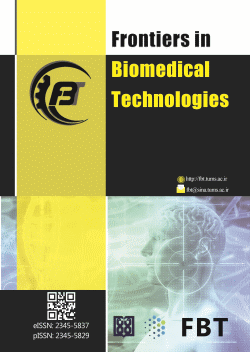A Proactive Technique for Pennation Angle Estimation of Skeletal Muscles Using Ultrasound Imaging
Abstract
Purpose: The concrete construction of the musculoskeletal modeling is efficiently performed using information obtained from patients rather than collected from cadavers. In this study, we have endeavored to propose an automated technique that calculates the skeletal muscle pennation angle of patient ultrasound images and compares it with manual evaluations of the same images.
Materials and Methods: The proposed technique consists of three steps after the process of collecting the data from 30 volunteers of different muscles of the upper and lower limb. The first step is to improve the contrast in the image and identify the important details in the image through the use of two methods that depend on a fuzzy inference system, and this step is considered essential to prepare the image in the next step. The Hough Transform was used to follow the muscle fibers and draw them as lines, this is the second step. The third step is to calculate the angle and compare it with the manual evaluation that was done depending on the ultrasound machine options.
Results: The results reveal that there is a slightly difference between manual and automated evaluations of pennation angle for biceps (upper limb muscle) and gastrocnemius (lower limb muscle) as 8.6% and 0.45% respectively. Furthermore, the manual assignment of pennation angles is significantly slower, taking minutes, while the automated approach takes only a few seconds. Automated measurements take 85% more time compared to manual measurements.
Conclusion: There is no significant difference between measurements based on t-test. In future work, we aspire to a wider application of this technique to other muscles in the body and to activate it as an option available in the ultrasound device.
2- R. I. Griffiths, “Shortening of muscle fibres during stretch of the active cat medial gastrocnemius muscle: the role of tendon compliance”, J. Physiol. 436, 219-236, (1991).
3- S. Barbat-Artigas, Y. Rolland, M. Zamboni, Aubertin-Leheudre. “How to assess functional status: a new muscle quality index. J Nutr Health Aging, 16:67–77, (2012). https://doi.org/10.1007/s12603-012-0004-5.
4- R. L. Lieber, J. Fridén, “Functional and clinical significance of skeletal muscle architecture”, Muscle Nerve.; 23:1647– 66, (2000). https://doi.org/10.1002/1097-4598(200011)23:11<1647::aid-mus1>3.0.co;2-m.
5- J. M. Taylor and D. F. Hug “Advances in imaging for assessing the design and mechanics of skeletal muscle in vivo”, Journal of Biomechanics,155111640, ISSN 0021-9290, (2023).
6- J. Hall Susan, “Basic biomechanics”. 6th ed, The Mc Graw Hill Companies, (1953).
7- R.D. Herbert and S C. Gandevia, “Changes in pennation with joint angle and muscle torque: in vivo measurements in human brachialis muscle.”, Journal of Physiology, 484(2), 523–532, (1995).
8- R. Giot, R Bourqui, N. Journet and A. Vialard, “Visual graph analysis for quality assessment of manually labelled documents image database.”, 13th International Conference on Document Analysis and Recognition, (2015) DOI: https://doi.org/10.1109/ICDAR.2015.7333938.
9- G. Q. Zhou and Y. P. Zheng, “Automatic Fascicle Length Estimation on Muscle Ultrasound Images with an Orientation-Sensitive Segmentation.”. IEEE Transaction of Biomedical Engineering, 62(12), 2828–2836, (2015).
10- M. Trevino, S. Perez, S. Sontag; A. Olmos, S. Jeon; L. Richardson “Influence of Pennation Angle and Muscle Thickness on Mechanomyographic Amplitude–Torque Relationships and Sex-Related Differences in the Vastus Lateralis.”, J. Funct. Morphol. Kinesiol., 8, 53, (2023). https://doi.org/ 10.3390/jfmk8020053
11- D. Cameron, D.A. Reiter, F. Adelnia, C. Ubaida-Mohien, C.M. Bergeron, S. Choi, K.W. Fishbein, R. G. Spencer, L. Ferrucci “Age-related changes in human skeletal muscle microstructure and architecture assessed by diffusion-tensor magnetic resonance imaging and their association with muscle strength." Aging Cell.;22(7):e13851, (2023). doi: 10.1111/acel.13851. Epub 2023 May 10. PMID: 37162031; PMCID: PMC10352548.
12- F.E. Jalborg, “Automatic detection of skeletal muscle architecture features.”, Master thesis, University of Oslo. (2016).
13- J. A. Canny, “Computational Approach to Edge Detection.”, IEEE Transaction on Pattern Analysis and Machine Intelligence, 8(6), 679–698, (1986).
14- L. Olewnik and et al. “A proposal for a new classification of soleus muscle”, Annals of Anatomy-Anatomischer Anzeiger, 2020 vol. 232, ,151584, pp. 1-7, (2020), DOI:10.1016/j.aanat.2020.151584
15- S. Katakis and et al. “Extraction of Muscle Parameters with Attention U Net in Ultrasonography.”, Sensors, 22, 5230, (2022). https://doi.org/10.3390/ s22145230
16- R. Cunningham, M.R. Sanchez, G. May, I. Loram, “Estimating full regional skeletal muscle fibre orientation from B-mode ultra- sound images using convolutional, residual, and deconvolutional neural networks.”, J Imaging;4(2):29, (2018).
17- Z. Weimin, L. Shangkun, C. Qing-Wei, P. Jeng-Shyang, and C. Shu-Chuan, “Automatic Measurement of Pennation Angle from Ultrasound Images using Resnets.”, Ultrasonic Imaging, Vol. 43(2) 74–87, (2021).
18- S.I. Jabbar, C. Day and E. Chadwick, “A new method of contrast enhancement of musculoskeletal ultrasound imaging based on fuzzy inference technique.”, Biomed. Phys. Eng. Express., 7, PP 1–11, (2021). DOI: 10.1088/2057-1976/ac0dce
19- S.I. Jabbar, C. Day and E. Chadwick, “Using Fuzzy Inference system for detection the edges of Musculoskeletal Ultrasound Images.”, 2019 IEEE International Conference on Fuzzy Systems (FUZZ-IEEE), pp. 1-7, (2019), doi: 10.1109/FUZZ-IEEE.2019.8858971.
20- P.V.C. Hough, “Method and means for recognizing complex patterns”, U.S. Patent, 3,069, 654, (1962).
21- Jalborg F.E. "Automatic detection of skeletal muscle architecture features.", Master thesis, University of Oslo. (2016).
22- R. O. Duda and P. E. Hart, “Use of the Hough transformation to detect lines and curves in pictures.”, Communications of the ACM, 15(1), 11–15, (1972).
23- A. Asadi,H. E. J.Veeger, E. K. Chadwick, M. Praagman, and F.C.T.Van Der Helm, “Development of a comprehensive musculoskeletal model of the shoulder and elbow.”, Medical. Biological. Engineering. Computing, 49(12), 1425–1435, (2011).
24- S.I. Jabbar, C. Day and E. Chadwick “Automated measurements of morphological parameters of muscles and tendons.”, Biomed. Phys.Eng. Express 7 (2), 1–11, 2021.
| Files | ||
| Issue | Articles in Press | |
| Section | Original Article(s) | |
| Keywords | ||
| Pennation Angle Skeletal Muscle Ultrasound Imaging Fuzzy Inference System and Hough Transform Biomedical Image Applications | ||
| Rights and permissions | |

|
This work is licensed under a Creative Commons Attribution-NonCommercial 4.0 International License. |




